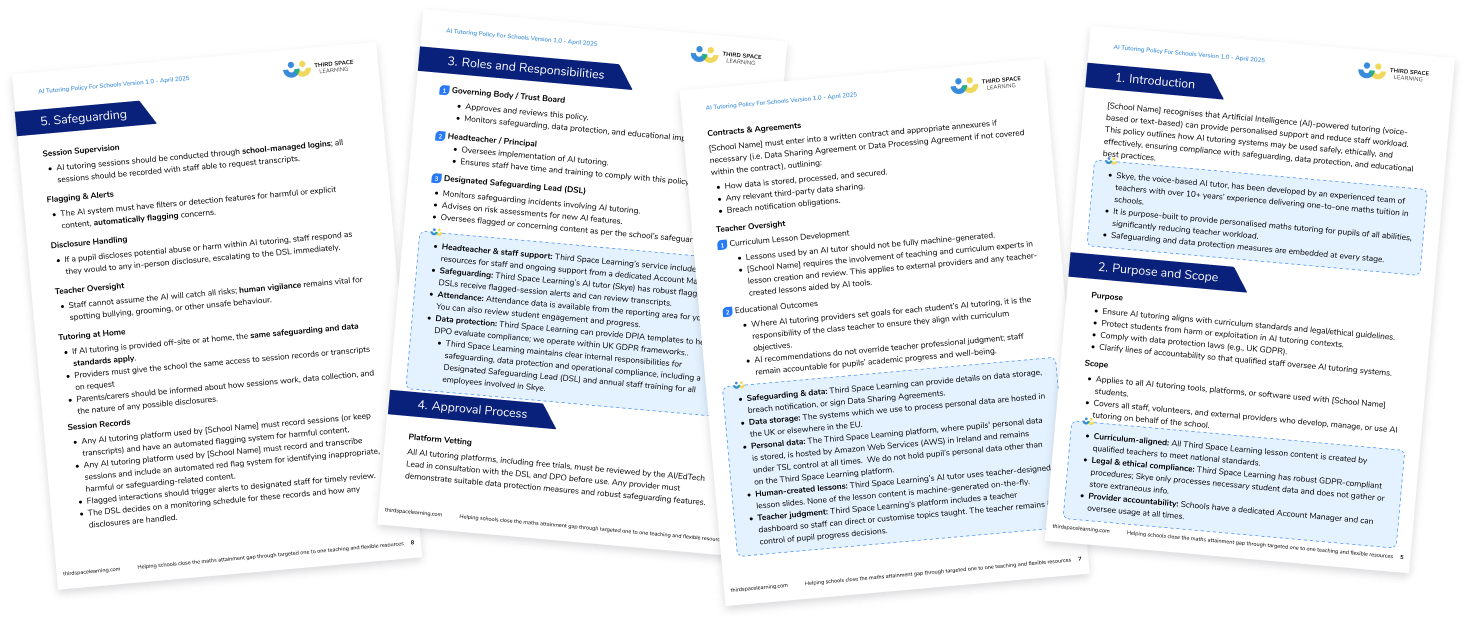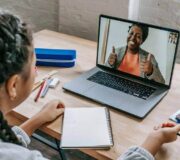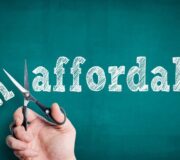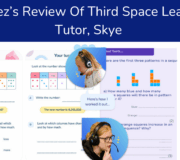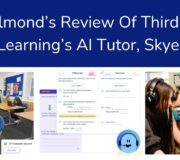AI Tutoring: A Practical Solution To Boost Maths Attainment
AI tutoring is taking hold across the school sector as leaders look to find an affordable way to provide one to one support to every student who needs it. It’s a key pillar in a growing market of AI tools, with 67% of secondary students and 60% of primary and secondary educators using them.
This article explains what AI tutoring is, outlines the current types, and lists key considerations for schools to make the most of this new educational technology in their settings.
What is AI tutoring?
AI tutoring is the use of artificial intelligence to deliver one-to-one academic support, enabling students to learn at their own pace. Many AI tutoring systems provide instant answers to student queries and offer explanations for complex topics.
More advanced intelligent tutoring systems (ITS) used for AI tutoring adapt instruction in real time, respond to pupil input, and provide immediate feedback.
Most AI tutors are accessed through a learning platform, where students engage in curriculum-aligned lessons. AI tutoring systems can break down complex subjects, such as maths, into easy-to-follow modules.
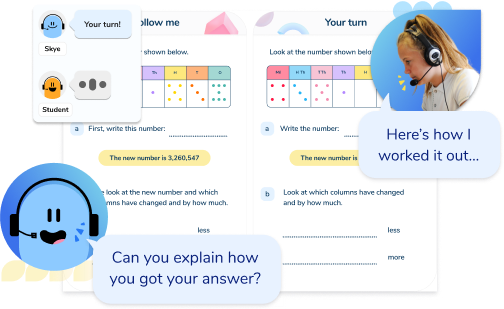
Discover how AI tutor, Skye, can improve your students’ confidence and maths results.
Get in touch to arrange a free AI maths tutoring session.
Try a free sessionThe best AI tutoring tools
Undoubtedly, the best AI tutors replicate the features of high-quality human tutoring, including:
- Clear explanations,
- Immediate feedback,
- Meaningful interaction,
- Personalised instruction.
You can find out more about the qualities of AI tutors in this comparison of the best AI tutors, including Third Space Learning’s AI tutor, Skye and Khanmigo.
Here’s a snapshot of the best AI tutors in one comparison matrix.
| Third Space Learning | Khanmigo | |
| Overview | Voice-based AI maths tutor that mimics one to one traditinal tutoring sessions | Khan Academy’s AI Socratic guide for text-based multi-subject study |
| Subjects covered | KS2 maths KS2 maths SATs GCSE maths Grade 3-8 math (US) | Maths Science Humanities Writing |
| Curriculum alignment | UK KS2 & GCSE maths curriculum alignment US grades 3-8 aligned with state standards | US Common Core Not aligned with the UK curriculum |
| Best for | Targeted maths intervention SATs/GCSE maths prep Disadvantaged pupils | Guided problem-solving Teacher lesson-plan support |
| Benefits and disadvantages | Benefits Unlimited personalised maths Real-time adaptive dialogue Proven pupil-progress data Disadvantages Maths only Needs headset & good internet School licenses only | Benefits Socratic prompts Instant feedback & hints Integrates with Khan Academy resources Disadvantages Not UK-aligned Some features paywalled No voice-based support |
| Pricing | From £3,500 per school per year for unlimited sessions for every pupil who needs it. | Core free School add-on $35 pp |
Download the full comparison matrix to compare each of the AI tutors side-by-side.
However, not everything labelled as AI tutoring meets this standard. Some AI tools simply generate questions or give instant answers.
Types of AI tutoring
There are different forms of AI tutoring tools to consider. Currently, the two most popular forms are:
- Text-based AI tutoring
- Spoken AI tutoring
Text-based AI tutoring
While helpful for practice problems, text-based AI tutors rely on writing skills and use written feedback, limiting accessibility for some learners. Often, text-based AI tutors struggle to diagnose misunderstandings or adapt lessons. Additionally, students may focus more on typing than on critical thinking
Spoken AI tutoring
Spoken AI tutors allow learners to speak and listen through a voice interface, mimicking a real conversation. Speech recognition and natural language processing let the AI powered tutor pivot instruction in real time, ideal for language learning or those who find writing challenging.
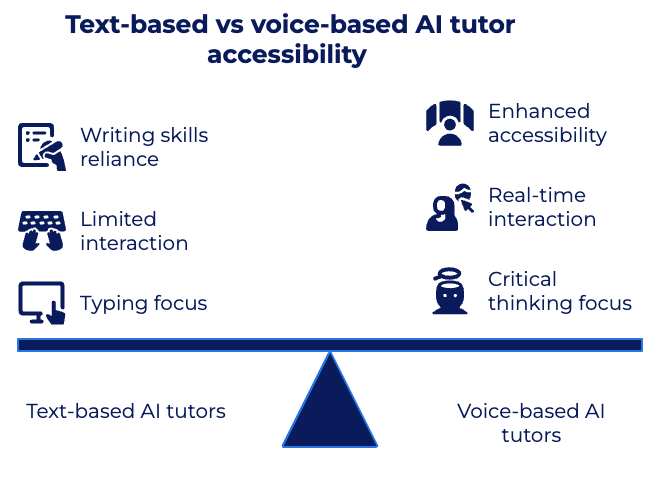
Consider how a text-based or spoken AI tutoring platform promotes student support and how well each replicates the features of effective one-to-one instruction.
Skye’s voice is crystal clear, and the pupils were really positive about that clarity.
David Gooding, Assistant Headteacher, Harrison Primary School
AI Tutoring in Schools: A Practical Guide to Improving Results Within Your Existing Budget
Use this clear step-by-step roadmap built on evidence-based impact to decide whether AI tutoring is right for your school.
Download Free Now!Adaptive learning through AI tutoring
High-quality AI tutors work as adaptive-learning engines. They analyse responses, update an internal model and adjust prompts to create an adaptive sequence. They also, without fail, have pedagogy not tech at the heart of their development, and likely a large number of teachers and subject specialists on the team training the AI tutor; this is the human in the loop that we deem essential for AI tutoring.
Less sophisticated AI tutoring models offer limited interaction, acting as technology-powered answer engines rather than personal tutors. While these AI tools provide direct answers, they miss opportunities to diagnose misconceptions or to support the student to reach the answer themselves.
Spoken AI maths tutoring built by teachers
In response to growing demand for accessible, cost-effective tutoring, Third Space Learning developed Skye, an AI maths tutor built by teachers and maths experts. Skye delivers one-to-one tutoring using the same pedagogical framework and lesson plans as traditional tutoring.
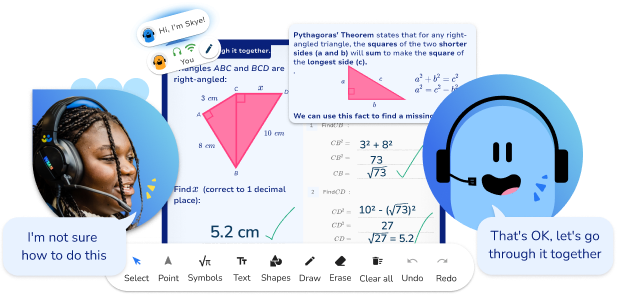
How Skye works:
- Students speak and listen throughout the session, making lessons highly accessible
- Lessons are scaffolded using “I do, we do, you do” to build understanding
- Every lesson is created by former teachers and aligned to the National Curriculum
- Adapts to learner responses in real time, offering prompts and learning pitched at the right pace
With pricing starting from £3,500 per year, schools can offer a personal tutor to every learner who needs it.
Why schools are choosing AI tutoring for maths
According to the Education Endowment Foundation tutoring report, traditional one‑to‑one tuition can add five months of progress. But, it costs around £45 per online session. AI tutoring delivers comparable student support at a lower cost.
Because AI maths tutoring can deliver low cost, personalised learning at scale, schools can provide access to extra help to more students.
Pricing comparison: cost of traditional tutoring vs cost of AI tutoring with Skye
For just the cost of a single AI tutoring licence, you can provide personalised support for hundreds of learners in your school, turning previously unaffordable interventions into everyday practice.
The biggest benefit for us is that now all students can have it because it’s unlimited for a much lower cost.
Deb Harris, Assistant Headteacher and Maths Lead, Wormley CofE Primary School
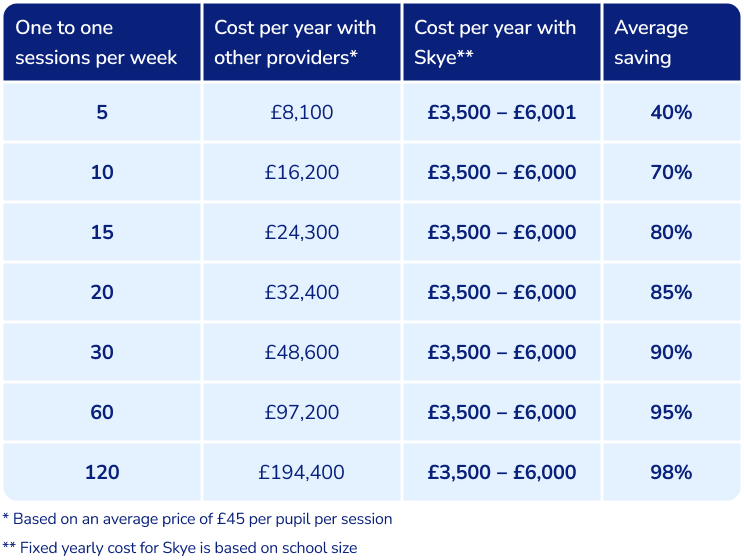
7 benefits of AI tutoring
Well-designed AI tutoring systems go beyond marking or instant answers. When grounded in proven pedagogy and guided by expert input, they can deliver effective one-to-one instruction that accelerates progress and reduces administrative tasks.
Here are the core benefits of using AI tutoring with your students:
1. Personalised learning
AI tutoring platforms analyse a student’s performance to identify strengths and weaknesses so each student receives the right content at the right time, at their own pace.
Skye, Third Space Learning’s AI tutor, begins with a diagnostic skill check in question and adapts the learning pathway in line with the national curriculum. Learners are guided step-by-step through lessons with hints and guidance as required.
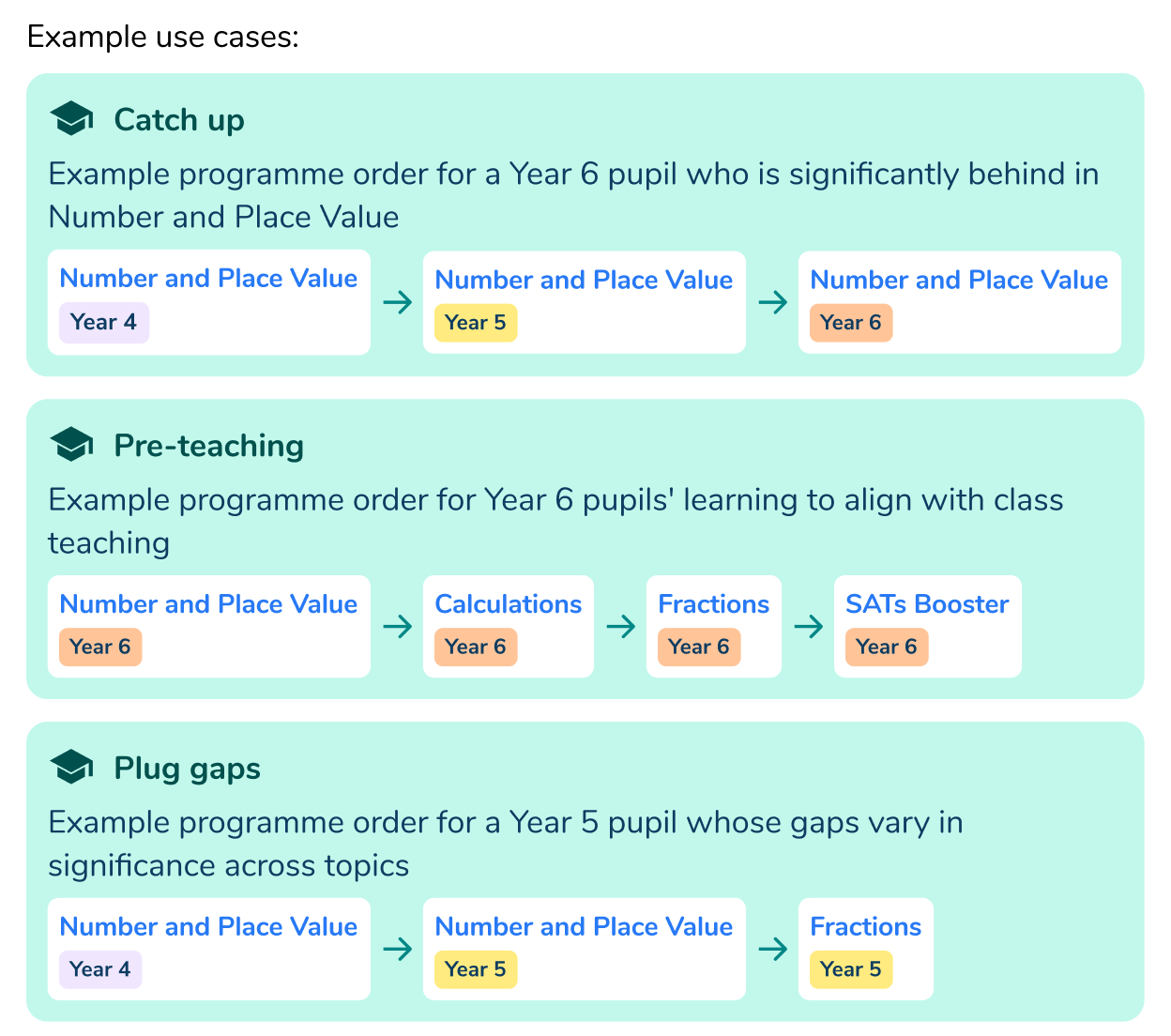
We can also use AI tutor Skye for same-day interventions. If we have a group of children who haven’t grasped a concept in their morning lesson, we can take them out and get it sorted with Third Space Learning in the afternoon.
Lucia Romeu, Assistant Headteacher, Danegrove Primary School
2. Better engagement and student participation
AI tutors can make learning more interactive and engaging, especially for students who struggle to participate in a whole class environment.
Real‑time dialogue keeps learners active and accountable. Prompts to explain reasoning encourage metacognition and perseverance.
AI tutors like Skye prompt learners to explain their reasoning to check students’ understanding, and give verbal encouragement to keep learners focused.
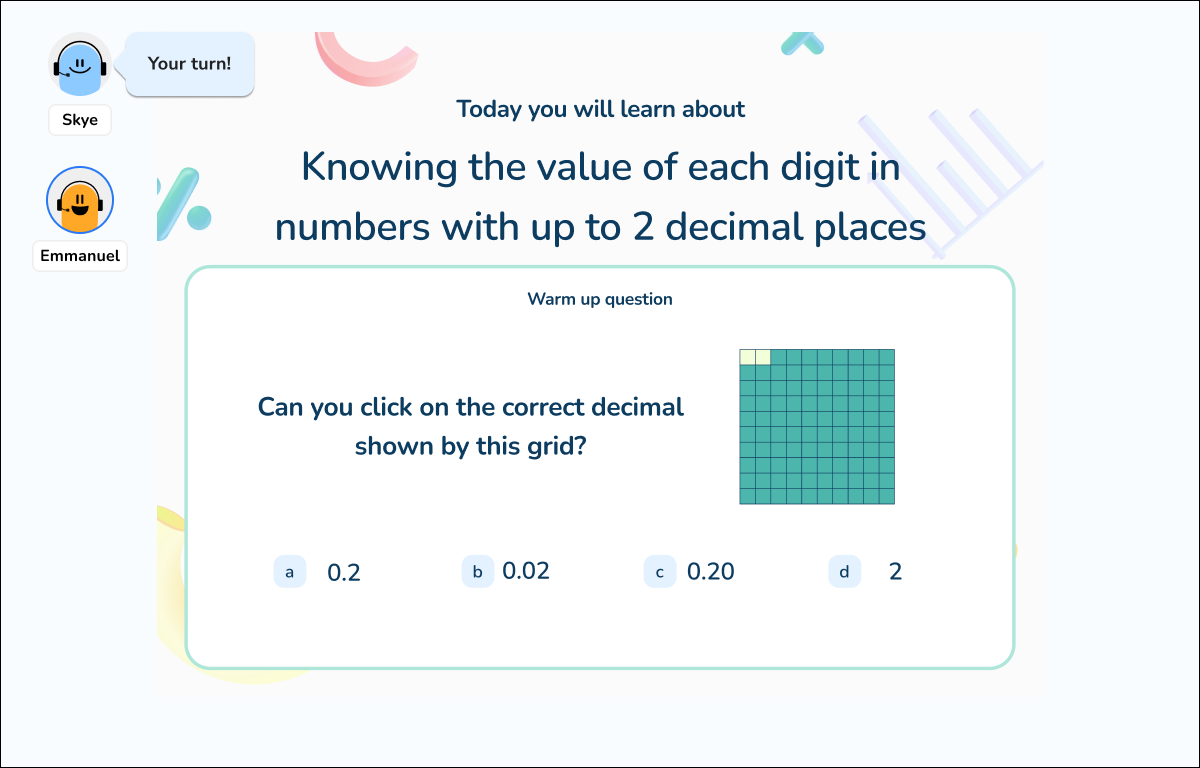
3. Data-driven insights
Every response to the AI tutor is captured and analysed, giving teachers clear evidence of progress and pinpointing gaps to address through future teaching in class.
After each AI tutoring session with Skye, the ITS generates a detailed report on the learning objective covered and whether it was achieved. These data-driven insights help teachers adapt classroom instruction and target students who need further support.

4. Improved accessibility
AI tutoring helps reduce the barriers for SEND and EAL students face. It can also make quality education more accessible to students in remote areas or those with limited resources.
Voice-based platforms, in particular, remove the need to read instructions or type long responses, allowing more students to access support independently.
All lessons are designed to reduce cognitive load, with simplified language, minimal on-screen text, and clear visuals. Students can ask Skye to repeat or rephrase instructions if they don’t understand, helping to ensure equitable access.

5. Instant feedback
AI tutors deliver on‑the‑spot corrections, which isn’t always possible in whole-class or small-group settings.
Skye offers up to three scaffolded hints, preventing further misconceptions and building independent learning.
6. Adaptive learning
The best AI tutors constantly adjust their instruction. Whether a student needs more explanation, simpler problems, or a challenge, the AI tutor adapts to the student’s understanding as they develop new skills.
7. Greater scalability and efficiency
Because AI tutors aren’t limited by tutor availability, entire cohorts can receive one‑to‑one support simultaneously without increasing workload or staffing. And each student will be focusing just on their specific needs.
Skye can run unlimited AI tutoring sessions simultaneously. Some schools are currently using Skye to deliver up to 120 sessions a week.
Read deputy headteacher and primary education expert, Neil Almond’s, independent review of Skye here and how it benefits pupils’ learning. Or EdTech Ninja Jodie Lopez’s AI tutoring review on how Skye provides tutoring to pupils who need it where tight budgets mean support might be lacking.
Challenges to consider
While AI tutoring presents many benefits, it’s not without challenges:
- Oversight: teachers still need to monitor content and respond to pupil needs.
- Equity: not every pupil has a quiet space or headset at home, though most platforms work well within school.
- Bias: monitoring AI systems for biases is necessary to ensure fairness in education.
- Training: staff benefit from basic training to understand features and optimise implementation.
- Safeguarding: all interactions must be monitored, recorded and reviewed.
- Data: transparency about AI’s data usage builds trust and encourages responsible use among students.
- Empathy: AI provides step-by-step feedback to prevent misconceptions, but human tutors offer emotional empathy and mentorship.
It works best when paired with professional judgement and high‑quality classroom teaching.
How AI tutoring is used in schools
AI in education is growing rapidly. Here are 5 ways schools like yours are already using AI tutoring to enhance learning and student outcomes.
- Revisit prior learning
- Practice key concepts
- Close learning gaps
- Prepare for exams
- Develop critical thinking, fluency and confidence
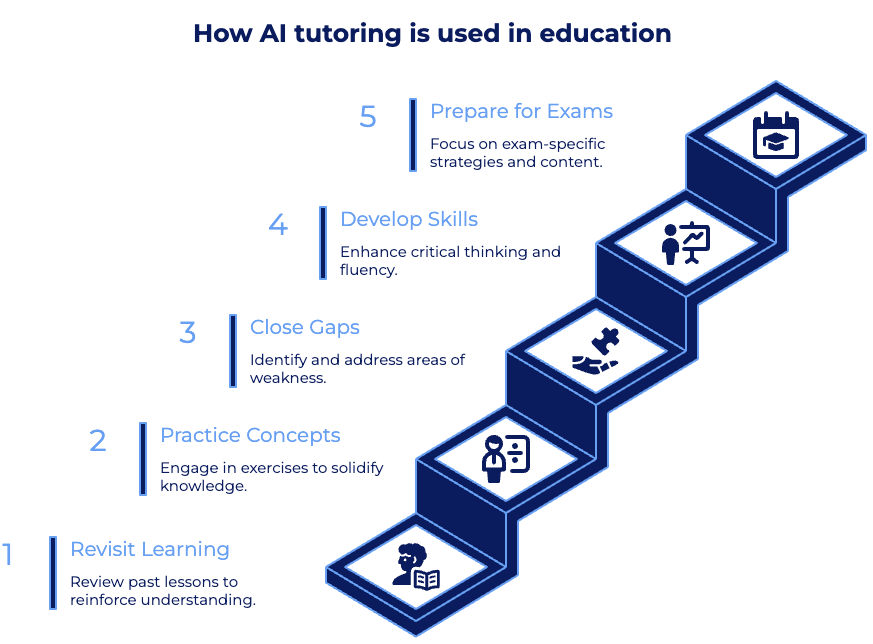
AI tutoring in practice with Skye
Across the UK, schools are embedding AI tutoring with Skye into their everyday provision to improve outcomes without increasing staff load. Here are 4 ways AI tutor Skye is improving student outcomes:
1. Catch-up interventions
Curriculum‑aligned, structured revision helps primary and secondary students consolidate knowledge quickly.
“The AI programme has allowed us to get more children onto the programme because it’s so affordable and more flexible, and the content is consistent.”
David Gooding, Deputy Headteacher
Harrison Primary School
2. Homework Help, practice tests and exam revision
On demand AI tutoring sessions beyond the classroom support homework and exam readiness.
Students engage in spoken dialogue as they revisit key topics independently, receiving immediate feedback.
3. One-to-one tutoring
AI tutoring removes cost and scheduling barriers, ensuring every student who needs extra help has access to it.
“This innovative one-to-one maths tutoring solution offers a cost-effective alternative to traditional one-to-one tutoring. The children are thoroughly enjoying the experience, and their engagement and focus are clearly evident.”
Chris Harris, Deputy Head
Admirals Academy, Norfolk
4. Lesson cover
During staff absence, AI maths tutors like Skye can step in as a virtual teaching assistant, launching sessions on demand.
Because Skye doesn’t rely on scheduling with a human tutor, sessions can be launched on demand and adjusted as needed.
What AI tutoring looks like in the classroom
A high-quality artificial intelligence tutoring session typically follows these steps:
- Diagnostic check: identifies gaps and informs the course content.
- Concept explanation: uses visuals and models to introduce new ideas.
- Guided practice: scaffolded practice problems to build understanding.
- Independent practice: encourages students to apply knowledge and demonstrate progress.
- Teacher insights: session data feeds into a dashboard, helping educators refine lesson planning and intervention.
Students using voice-based AI maths tutoring often verbalise reasoning, strengthening mathematical fluency and reinforcing knowledge.
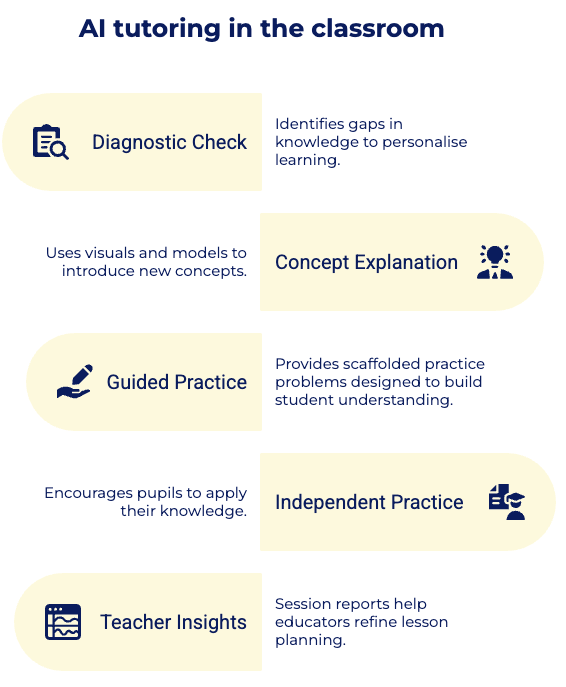
What to look for in an AI tutoring tool
Not all AI tools work in the same way or provide the same level of support. When assessing options, school leaders should ask providers whether:
- Content is national curriculum-aligned
- Lessons are created by qualified teachers or generated by AI
- The platform provides a custom learning pathway
- AI tutors give feedback and adapt lessons in real time
- Sessions are recorded for safety
- The platform is GDPR-compliant and safe for all users
- It supports language learning for students with SEND
- Lesson plans and resources are age-appropriate
Find out more about what Ofsted inspectors may look for in AI use in education.
Safeguarding and data protection
Any AI powered classroom tool should have safeguarding and privacy built in. At Third Space Learning, Skye is designed with safety in mind:
- Only authorised staff schedule sessions
- Students interact with vetted lesson slides, no open web access
- All sessions are recorded, transcribed and reviewed
- Safeguarding flags are raised automatically
- Student data is never used to retrain the AI
How to implement AI tutoring in your school
- Define goals and priority groups
- Choose AI tools and check edtech requirements
- Pilot with a small group of students
- Scale up to other cohorts
- Embed CPD for staff
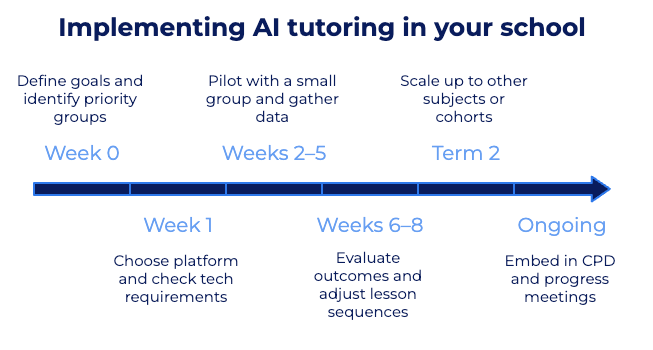
Find out more about online one to one maths tutoring with Skye:
Online one to one AI maths tutoring for primary schools
Online one to one AI maths tutoring for secondary schools
Final thoughts
AI tutoring is not a replacement for teachers; it’s a tool that uses the best online tutoring strategies to enhance learning and help students achieve their full potential. For AI tutoring to be fully effective, schools must have a comprehensive understanding of AI literacy and assess where it fits in their framework and policy.
Whether you’re looking to close attainment gaps, prepare for exams, or free up staff time, AI powered education offers a practical, affordable solution.
It’s one way of making education more inclusive, efficient and effective for every student, in every classroom.
READ MORE:
- Online Tutoring: A Complete Guide To Everything Schools Should Know Before They Start
- The 5 Best Online Tutoring Websites For Primary & Secondary Students
- How To Use AI For Maths: A Practical Guide For Teachers And Heads of Department
- Supercharge Your Maths Teaching with ChatGPT & LLMs: Prompts, Tips, and Pitfalls
- The Best AI For Maths: A Comparison For Schools
AI tutoring FAQs
AI tutoring delivers large-scale, adaptive one-to-one support at a fraction of traditional tuition costs. When the platform is evidence-based, curriculum-aligned and embeds safeguarding, AI tutoring provides improved attainment.
Costs vary by licence model. A one-form entry voice-based licence such as Skye’s is around £3,500 annually and can serve hundreds of learners, pushing the per-student price down to only a few pounds per year. Other platforms like Khan academy offer their AI tool on a private subscription parents can pay for monthly.
Both are highly effective. Human tutors excel at empathy, nuanced questioning and classroom context, making them ideal for emotional support. AI tutors, powered by adaptive-learning algorithms, offer immediate feedback, unlimited availability, rich data and consistent safeguarding controls.
Yes. Ofsted’s April 2024 policy paper states it “supports the use of AI by providers where it improves the education and care of children.” The DfE’s January 2025 guidance similarly encourages safe, effective adoption, emphasising safeguarding, data protection and curriculum alignment.
DO YOU HAVE STUDENTS WHO NEED MORE SUPPORT IN MATHS?
Skye – our AI maths tutor built by teachers – gives students personalised one-to-one lessons that address learning gaps and build confidence.
Since 2013 we’ve taught over 2 million hours of maths lessons to more than 170,000 students to help them become fluent, able mathematicians.
Explore our AI maths tutoring or find out about online maths tuition for your school.



